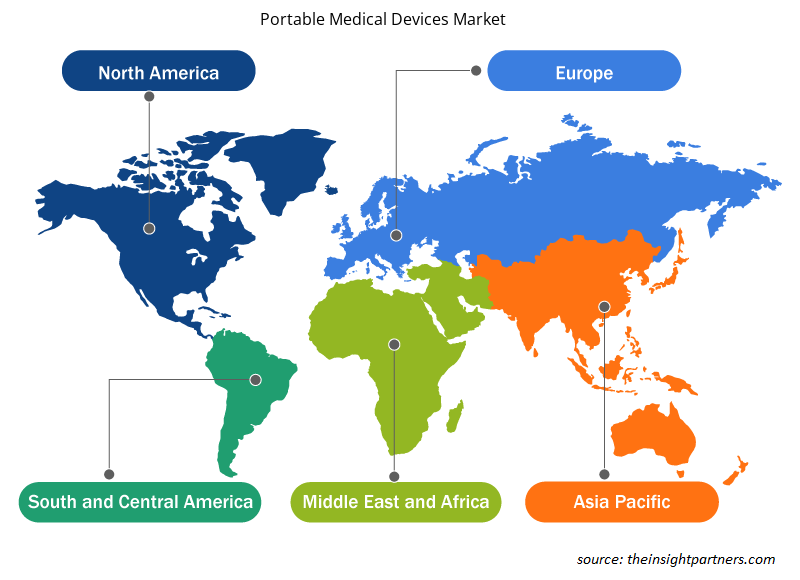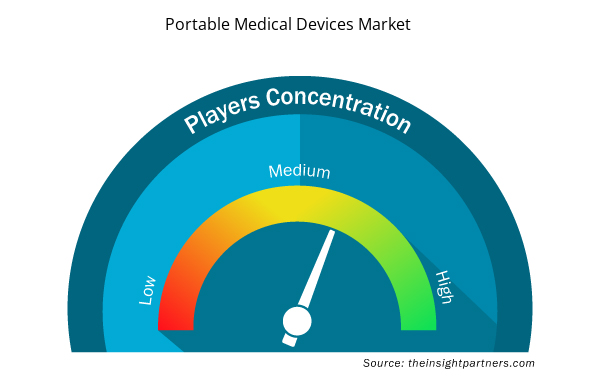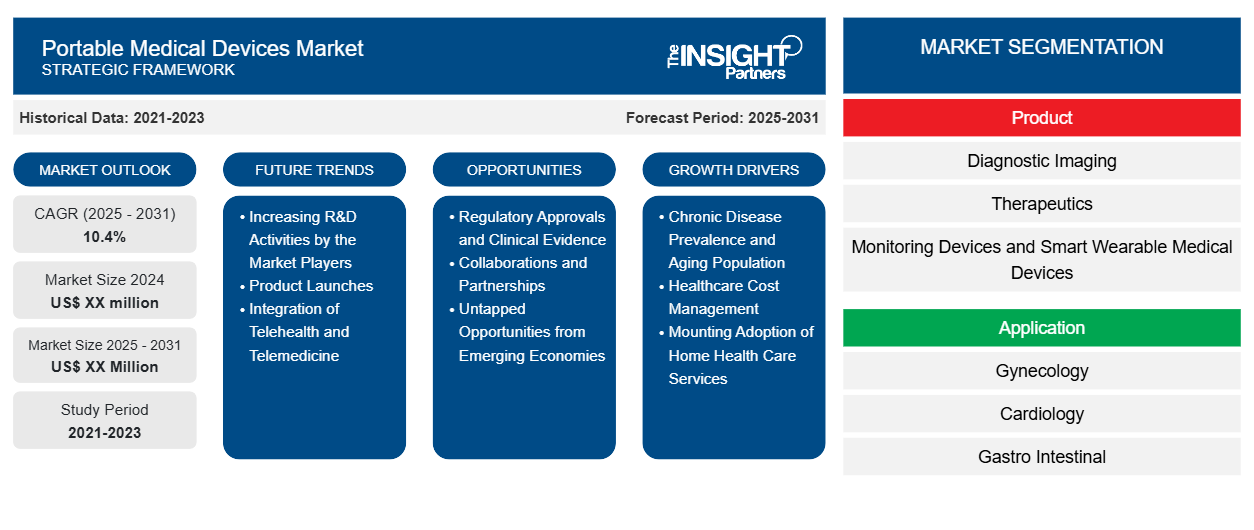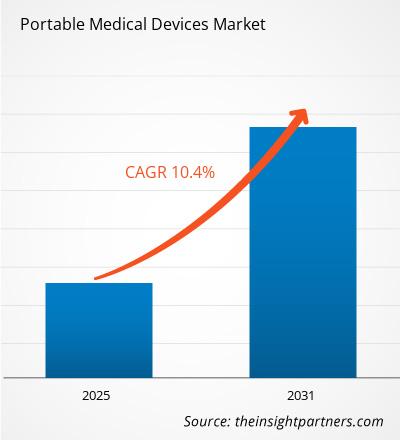Der Markt für tragbare medizinische Geräte wird voraussichtlich von 2024 bis 2031 eine durchschnittliche jährliche Wachstumsrate (CAGR) von 10,4 % verzeichnen, wobei die Marktgröße von XX Millionen US-Dollar im Jahr 2024 auf XX Millionen US-Dollar im Jahr 2031 wachsen wird.CAGR of 10.4% from 2024 to 2031, with a market size expanding from US$ XX million in 2024 to US$ XX Million by 2031.
Der Bericht ist nach Produkt (Diagnosebildgebung, Therapeutika, Überwachungsgeräte und intelligente tragbare medizinische Geräte) und Anwendung (Gynäkologie, Kardiologie, Magen-Darm, Urologie, Neurologie, Atemwege, Orthopädie und andere) segmentiert. Die globale Analyse ist weiter auf regionaler Ebene und nach wichtigen Ländern aufgeschlüsselt. Der Bericht bietet den Wert in USD für die oben genannte Analyse und die Segmente.Gastro Intestinal, Urology, Neurology, Respiratory, Orthopedics and Others). The global analysis is further broken-down at regional level and major countries. The Report Offers the Value in USD for the above analysis and segments.
Zweck des Berichts
Der Bericht „Markt für tragbare medizinische Geräte“ von The Insight Partners soll die aktuelle Situation und das zukünftige Wachstum sowie die wichtigsten treibenden Faktoren, Herausforderungen und Chancen beschreiben. Dies wird verschiedenen Geschäftspartnern Einblicke geben, wie zum Beispiel:
- Technologieanbieter/-hersteller: Um die sich entwickelnde Marktdynamik zu verstehen und die potenziellen Wachstumschancen zu kennen, damit sie fundierte strategische Entscheidungen treffen können.
- Investoren: Durchführung einer umfassenden Trendanalyse hinsichtlich der Marktwachstumsrate, der finanziellen Marktprognosen und der Chancen entlang der Wertschöpfungskette.
- Regulierungsbehörden: Zur Regulierung von Richtlinien und Überwachungsaktivitäten auf dem Markt mit dem Ziel, Missbrauch zu minimieren, das Vertrauen der Anleger zu bewahren und die Integrität und Stabilität des Marktes aufrechtzuerhalten.
Tragbare medizinische Geräte Marktsegmentierung
Produkt
- Diagnostische Bildgebung
- Therapeutika
- Überwachungsgeräte und intelligente tragbare medizinische Geräte
Anwendung
- Gynäkologie
- Kardiologie
- Magen-Darm
- Urologie
- Neurologie
- Atemwege
- Orthopädie und Sonstiges
Passen Sie diesen Bericht Ihren Anforderungen an
Sie erhalten kostenlos individuelle Anpassungen an jedem Bericht, einschließlich Teilen dieses Berichts oder einer Analyse auf Länderebene, eines Excel-Datenpakets sowie tolle Angebote und Rabatte für Start-ups und Universitäten.
- Holen Sie sich die wichtigsten Markttrends aus diesem Bericht.Dieses KOSTENLOSE Beispiel umfasst eine Datenanalyse von Markttrends bis hin zu Schätzungen und Prognosen.
Wachstumstreiber auf dem Markt für tragbare medizinische Geräte
- Prävalenz chronischer Krankheiten und alternde Bevölkerung: Der weltweite Anstieg der Zahl der Menschen, die an chronischen Krankheiten wie Diabetes und Krebs leiden, sowie die zunehmende Alterung der Bevölkerung sind die größten Markttreiber für tragbare medizinische Geräte. Da immer mehr Menschen eine kontinuierliche Überwachung und Behandlung ihres Gesundheitszustands benötigen, ist die Nachfrage nach tragbaren Lösungen gestiegen.
- Kostenmanagement im Gesundheitswesen: Chronische Krankheiten wie Diabetes und Krebs werden zu einem der Haupttreiber der Kosten im Gesundheitswesen. Daher sind sowohl die Patienten als auch das Gesundheitssystem bestrebt, nach besseren Behandlungsmöglichkeiten zu suchen. Tragbare medizinische Geräte wie Insulinpumpen und tragbare Ultraschallgeräte ermöglichen eine proaktive Überwachung, die im Laufe der Zeit teure und kostenintensive Eingriffe vermeiden kann. Darüber hinaus motiviert das zunehmende Bewusstsein der Bevölkerung für Gesundheit und Wohlbefinden diese dazu, Geld für tragbare medizinische Geräte auszugeben. Im Allgemeinen werden die Geräte mit ständig steigenden Einkommen und besserer Verfügbarkeit der Technologie leichter zugänglich.consiousness of health and wellness among the population is motivating them to spend on portable medical devices. In general, with constantly increasing levels of income and better availability of technology, the device becomes more readily accessible.
- Zunehmende Nutzung von häuslichen Gesundheitspflegediensten: Es gibt einen deutlichen Trend hin zur häuslichen Gesundheitspflege, bei der Patienten es vorziehen, ihren Gesundheitszustand bequem von zu Hause aus zu verwalten. Dies hat zu einer höheren Nachfrage nach tragbaren medizinischen Geräten wie Blutzuckermessgeräten, Insulinpumpen, Pulsoximetern und tragbaren Geräten geführt, die eine kontinuierliche Überwachung und Behandlung chronischer Erkrankungen ermöglichen.oximeter, and wearable devices that facilitate continuous monitoring and management of chronic conditions.
Markttrends für tragbare medizinische Geräte
- Steigende F&E-Aktivitäten der Marktteilnehmer: Führende Hersteller wie Medtronic, Philips und Omron Healthcare, Inc. forschen und entwickeln an modernen Technologien wie tragbaren Pumpen und tragbaren Diagnosegeräten, um lange Krankenhausaufenthalte zu verkürzen und die Selbstmedikation zu fördern. Solche F&E-Aktivitäten dieser Marktteilnehmer werden das Wachstum des Marktanteils tragbarer medizinischer Geräte fördern.
- Produkteinführungen: Die Einführung moderner tragbarer medizinischer Geräte für die häusliche Pflege als Ersatz für lange Krankenhausaufenthalte dürften die zukünftigen Trends auf dem Markt für mechanische Beatmungsgeräte sein. Mehrere tragbare Geräte wie Pulsmessgeräte bieten drahtlose Konnektivität, Ferndiagnose usw., sodass Gesundheitsdienstleister Patienten aus der Ferne überwachen und Einstellungen in Echtzeit anpassen können. Diese sind zu unverzichtbaren Werkzeugen in der modernen Diagnostik und häuslichen Pflege geworden, und ihre Einführung wird voraussichtlich das Wachstum des Marktes ankurbeln.
- Integration von Telemedizin und Telegesundheit:
Tragbare medizinische Geräte, die sich problemlos in virtuelle Gesundheitsumgebungen integrieren lassen, profitieren von der wachsenden Popularität von Telemedizin und Telegesundheit. Dazu gehören digitale Stethoskope, tragbare Diagnosegeräte und andere tragbare medizinische Geräte, mit denen medizinisches Fachpersonal virtuelle Konsultationen durchführen, Krankheiten diagnostizieren und Medikamente verschreiben kann, während die Telemedizin auf Distanz bleibt. Dieser Trend fördert den Zugang zu Pflegediensten, insbesondere an abgelegenen und schwer erreichbaren Orten, und belebt wiederum den Markt für tragbare medizinische Geräte.
Marktchancen für tragbare medizinische Geräte
- Zulassungen und klinische Nachweise: Die Erlangung von Zulassungen und deren Untermauerung mit klinischen Daten kann das Vertrauen von Verbrauchern und Ärzten stärken. Klare Zulassungswege und neue Zulassungen für tragbare medizinische Geräte wie tragbare Ultraschallscanner, Sonden und andere Geräte fördern Innovationen und können dazu führen, dass mehr Optionen auf dem Markt verfügbar sind.
- Kooperationen und Partnerschaften: Kooperationen mit Chirurgen, Spezialisten verschiedener medizinischer Abteilungen und anderen medizinischen Fachkräften können die Glaubwürdigkeit und Marktreichweite erhöhen. Diese Partnerschaften können auch klinische Studien erleichtern, die die Wirksamkeit von Produkten bestätigen. Darüber hinaus können verstärkte Kooperationen zwischen Herstellern oder Fusionen dazu beitragen, ihr Produktangebot zu verbessern und ihre Marktreichweite zu vergrößern. Dies kann die F&E-Kapazitäten verbessern und Innovationen bei tragbaren medizinischen Geräten vorantreiben.
- Ungenutzte Chancen in Schwellenländern: In Schwellenmärkten, insbesondere im asiatisch-pazifischen Raum, in Lateinamerika und im Nahen Osten, steigen die verfügbaren Einkommen und das damit einhergehende wachsende Bewusstsein für nicht-invasive Techniken für häusliche Gesundheitspflegedienste. Dies führt zu einer Nachfrage nach tragbaren medizinischen Geräten. Darüber hinaus bieten die wachsenden Vertriebsnetze in diesen Regionen erhebliche Wachstumschancen auf dem Markt für tragbare medizinische Geräte.
Regionale Einblicke in den Markt für tragbare medizinische Geräte
Die regionalen Trends und Faktoren, die den Markt für tragbare medizinische Geräte während des gesamten Prognosezeitraums beeinflussen, wurden von den Analysten von Insight Partners ausführlich erläutert. In diesem Abschnitt werden auch die Marktsegmente und die Geografie für tragbare medizinische Geräte in Nordamerika, Europa, im asiatisch-pazifischen Raum, im Nahen Osten und Afrika sowie in Süd- und Mittelamerika erörtert.

- Erhalten Sie regionale Daten zum Markt für tragbare medizinische Geräte
Umfang des Marktberichts über tragbare medizinische Geräte
| Berichtsattribut | Details |
|---|---|
| Marktgröße im Jahr 2024 | XX Millionen US-Dollar |
| Marktgröße bis 2031 | XX Millionen US-Dollar |
| Globale CAGR (2025 - 2031) | 10,4 % |
| Historische Daten | 2021-2023 |
| Prognosezeitraum | 2025–2031 |
| Abgedeckte Segmente | Nach Produkt
|
| Abgedeckte Regionen und Länder | Nordamerika
|
| Marktführer und wichtige Unternehmensprofile |
|
Dichte der Marktteilnehmer für tragbare medizinische Geräte: Auswirkungen auf die Geschäftsdynamik verstehen
Der Markt für tragbare medizinische Geräte wächst rasant, angetrieben durch die steigende Nachfrage der Endnutzer aufgrund von Faktoren wie sich entwickelnden Verbraucherpräferenzen, technologischen Fortschritten und einem größeren Bewusstsein für die Vorteile des Produkts. Mit steigender Nachfrage erweitern Unternehmen ihr Angebot, entwickeln Innovationen, um die Bedürfnisse der Verbraucher zu erfüllen, und nutzen neue Trends, was das Marktwachstum weiter ankurbelt.
Die Marktteilnehmerdichte bezieht sich auf die Verteilung der Firmen oder Unternehmen, die in einem bestimmten Markt oder einer bestimmten Branche tätig sind. Sie gibt an, wie viele Wettbewerber (Marktteilnehmer) in einem bestimmten Marktraum im Verhältnis zu seiner Größe oder seinem gesamten Marktwert präsent sind.
Die wichtigsten auf dem Markt für tragbare medizinische Geräte tätigen Unternehmen sind:
- Medtronic
- KONINKLIJKE PHILIPS NV
- Allgemeine Elektrizit?tsgesellschaft
- Abbott
- Omron Healthcare, Inc.
Haftungsausschluss : Die oben aufgeführten Unternehmen sind nicht in einer bestimmten Reihenfolge aufgeführt.

- Überblick über die wichtigsten Akteure auf dem Markt für tragbare medizinische Geräte
Wichtige Verkaufsargumente
- Umfassende Abdeckung: Der Bericht deckt die Analyse der Produkte, Dienste, Typen und Endbenutzer des Marktes für tragbare medizinische Geräte umfassend ab und bietet einen ganzheitlichen Überblick.
- Expertenanalyse: Der Bericht basiert auf dem umfassenden Verständnis von Branchenexperten und Analysten.
- Aktuelle Informationen: Der Bericht stellt durch die Abdeckung aktueller Informationen und Datentrends Geschäftsrelevanz sicher.
- Anpassungsoptionen: Dieser Bericht kann angepasst werden, um spezifische Kundenanforderungen zu erfüllen und die Geschäftsstrategien optimal anzupassen.
Der Forschungsbericht zum Markt für tragbare medizinische Geräte kann daher dabei helfen, die Branchensituation und Wachstumsaussichten zu entschlüsseln und zu verstehen. Obwohl es einige berechtigte Bedenken geben kann, überwiegen die allgemeinen Vorteile dieses Berichts tendenziell die Nachteile.
- Historische Analyse (2 Jahre), Basisjahr, Prognose (7 Jahre) mit CAGR
- PEST- und SWOT-Analyse
- Marktgröße Wert/Volumen – Global, Regional, Land
- Branche und Wettbewerbsumfeld
- Excel-Datensatz



Report Coverage
Revenue forecast, Company Analysis, Industry landscape, Growth factors, and Trends

Segment Covered
This text is related
to segments covered.

Regional Scope
North America, Europe, Asia Pacific, Middle East & Africa, South & Central America

Country Scope
This text is related
to country scope.
Häufig gestellte Fragen
Asia Pacific is estimated to grow at the highest CAGR over the forecast year (2023 - 2031)
The North America region accounts for highest revenue share portable medical devices market
The final report will duly include market size and projection estimates for all the segments from 2021 to 2031, along with a revenue share and compound annual growth rate (%) for the regional
/
country-wise market wherein 2021-2022 are the historic years, 2023 is considered to be the base year, and the forecast will be provided till 2031, along with CAGR (%)
The market is expected to grow at a CAGR of 10.4%
Chronic disease prevalence and aging population is the major factors boosting the portable medical devices market growth.
Medtronic,
KONINKLIJKE PHILIPS N.V.,
General Electric Company,
Abbott,
Omron Healthcare, Inc., F. Hoffmann-La Roche Ltd, Natus Medical Incorporated, BD, OmniVision Technologies, Inc are the some of the key market players operating in the portable medical devices Market market
Trends and growth analysis reports related to Life Sciences : READ MORE..
1. Medtronic
2. KONINKLIJKE PHILIPS N.V.
3. General Electric Company
4. Abbott
5. Omron Healthcare, Inc.
6. F. Hoffmann-La Roche Ltd
7. Natus Medical Incorporated
8. BD
9. OmniVision Technologies, Inc.
10. Infineon Technologies AG
The Insight Partners performs research in 4 major stages: Data Collection & Secondary Research, Primary Research, Data Analysis and Data Triangulation & Final Review.
- Data Collection and Secondary Research:
As a market research and consulting firm operating from a decade, we have published and advised several client across the globe. First step for any study will start with an assessment of currently available data and insights from existing reports. Further, historical and current market information is collected from Investor Presentations, Annual Reports, SEC Filings, etc., and other information related to company’s performance and market positioning are gathered from Paid Databases (Factiva, Hoovers, and Reuters) and various other publications available in public domain.
Several associations trade associates, technical forums, institutes, societies and organization are accessed to gain technical as well as market related insights through their publications such as research papers, blogs and press releases related to the studies are referred to get cues about the market. Further, white papers, journals, magazines, and other news articles published in last 3 years are scrutinized and analyzed to understand the current market trends.
- Primary Research:
The primarily interview analysis comprise of data obtained from industry participants interview and answers to survey questions gathered by in-house primary team.
For primary research, interviews are conducted with industry experts/CEOs/Marketing Managers/VPs/Subject Matter Experts from both demand and supply side to get a 360-degree view of the market. The primary team conducts several interviews based on the complexity of the markets to understand the various market trends and dynamics which makes research more credible and precise.
A typical research interview fulfils the following functions:
- Provides first-hand information on the market size, market trends, growth trends, competitive landscape, and outlook
- Validates and strengthens in-house secondary research findings
- Develops the analysis team’s expertise and market understanding
Primary research involves email interactions and telephone interviews for each market, category, segment, and sub-segment across geographies. The participants who typically take part in such a process include, but are not limited to:
- Industry participants: VPs, business development managers, market intelligence managers and national sales managers
- Outside experts: Valuation experts, research analysts and key opinion leaders specializing in the electronics and semiconductor industry.
Below is the breakup of our primary respondents by company, designation, and region:

Once we receive the confirmation from primary research sources or primary respondents, we finalize the base year market estimation and forecast the data as per the macroeconomic and microeconomic factors assessed during data collection.
- Data Analysis:
Once data is validated through both secondary as well as primary respondents, we finalize the market estimations by hypothesis formulation and factor analysis at regional and country level.
- Macro-Economic Factor Analysis:
We analyse macroeconomic indicators such the gross domestic product (GDP), increase in the demand for goods and services across industries, technological advancement, regional economic growth, governmental policies, the influence of COVID-19, PEST analysis, and other aspects. This analysis aids in setting benchmarks for various nations/regions and approximating market splits. Additionally, the general trend of the aforementioned components aid in determining the market's development possibilities.
- Country Level Data:
Various factors that are especially aligned to the country are taken into account to determine the market size for a certain area and country, including the presence of vendors, such as headquarters and offices, the country's GDP, demand patterns, and industry growth. To comprehend the market dynamics for the nation, a number of growth variables, inhibitors, application areas, and current market trends are researched. The aforementioned elements aid in determining the country's overall market's growth potential.
- Company Profile:
The “Table of Contents” is formulated by listing and analyzing more than 25 - 30 companies operating in the market ecosystem across geographies. However, we profile only 10 companies as a standard practice in our syndicate reports. These 10 companies comprise leading, emerging, and regional players. Nonetheless, our analysis is not restricted to the 10 listed companies, we also analyze other companies present in the market to develop a holistic view and understand the prevailing trends. The “Company Profiles” section in the report covers key facts, business description, products & services, financial information, SWOT analysis, and key developments. The financial information presented is extracted from the annual reports and official documents of the publicly listed companies. Upon collecting the information for the sections of respective companies, we verify them via various primary sources and then compile the data in respective company profiles. The company level information helps us in deriving the base number as well as in forecasting the market size.
- Developing Base Number:
Aggregation of sales statistics (2020-2022) and macro-economic factor, and other secondary and primary research insights are utilized to arrive at base number and related market shares for 2022. The data gaps are identified in this step and relevant market data is analyzed, collected from paid primary interviews or databases. On finalizing the base year market size, forecasts are developed on the basis of macro-economic, industry and market growth factors and company level analysis.
- Data Triangulation and Final Review:
The market findings and base year market size calculations are validated from supply as well as demand side. Demand side validations are based on macro-economic factor analysis and benchmarks for respective regions and countries. In case of supply side validations, revenues of major companies are estimated (in case not available) based on industry benchmark, approximate number of employees, product portfolio, and primary interviews revenues are gathered. Further revenue from target product/service segment is assessed to avoid overshooting of market statistics. In case of heavy deviations between supply and demand side values, all thes steps are repeated to achieve synchronization.
We follow an iterative model, wherein we share our research findings with Subject Matter Experts (SME’s) and Key Opinion Leaders (KOLs) until consensus view of the market is not formulated – this model negates any drastic deviation in the opinions of experts. Only validated and universally acceptable research findings are quoted in our reports.
We have important check points that we use to validate our research findings – which we call – data triangulation, where we validate the information, we generate from secondary sources with primary interviews and then we re-validate with our internal data bases and Subject matter experts. This comprehensive model enables us to deliver high quality, reliable data in shortest possible time.


 Holen Sie sich ein kostenloses Muster für diesen Bericht
Holen Sie sich ein kostenloses Muster für diesen Bericht